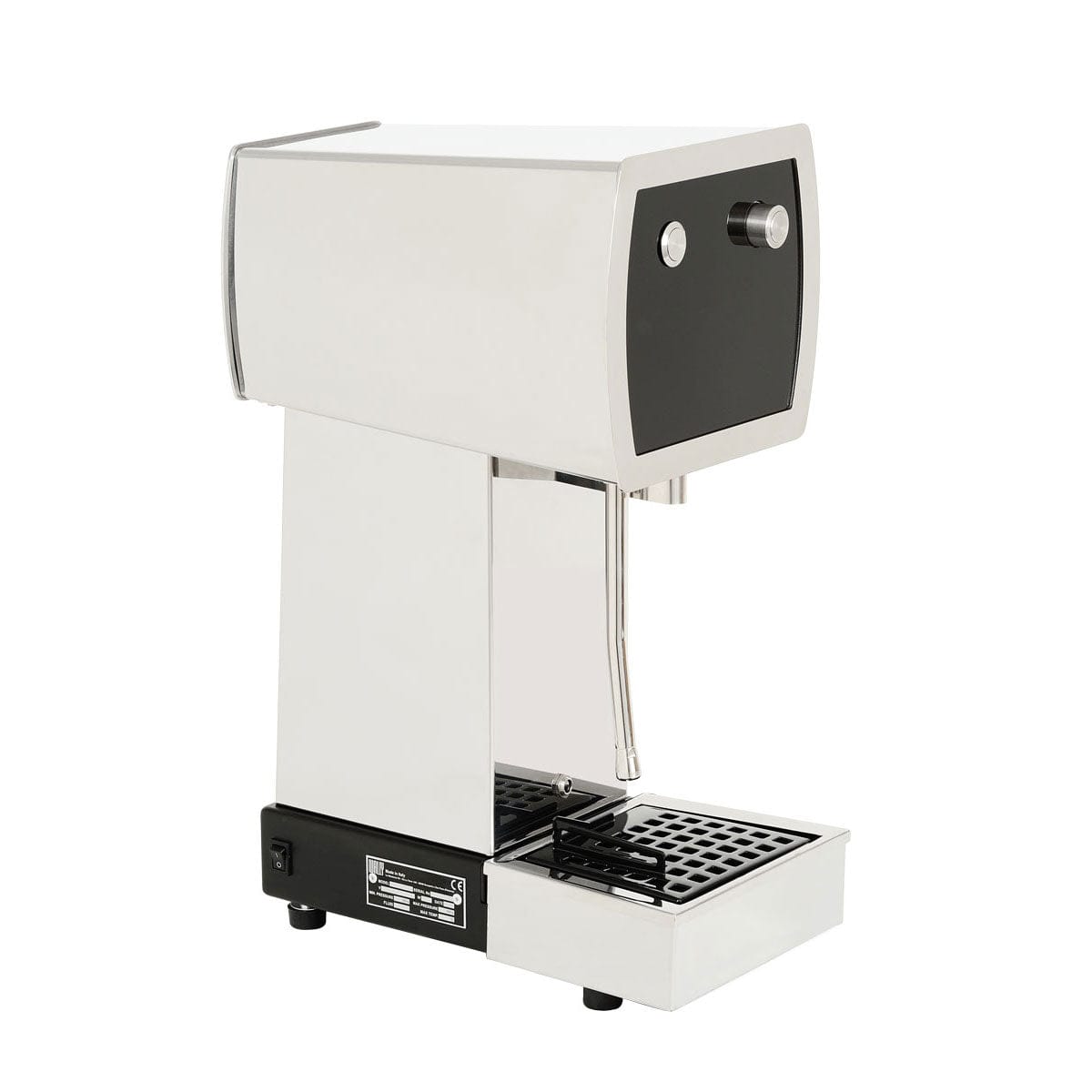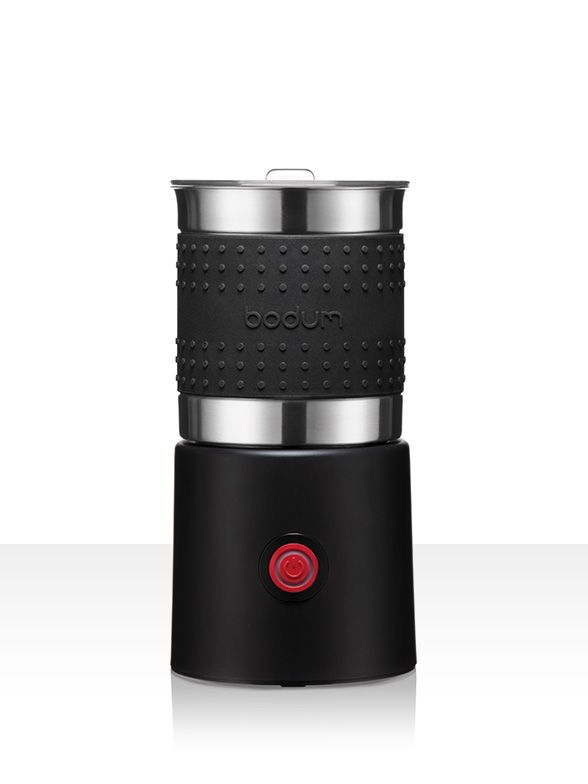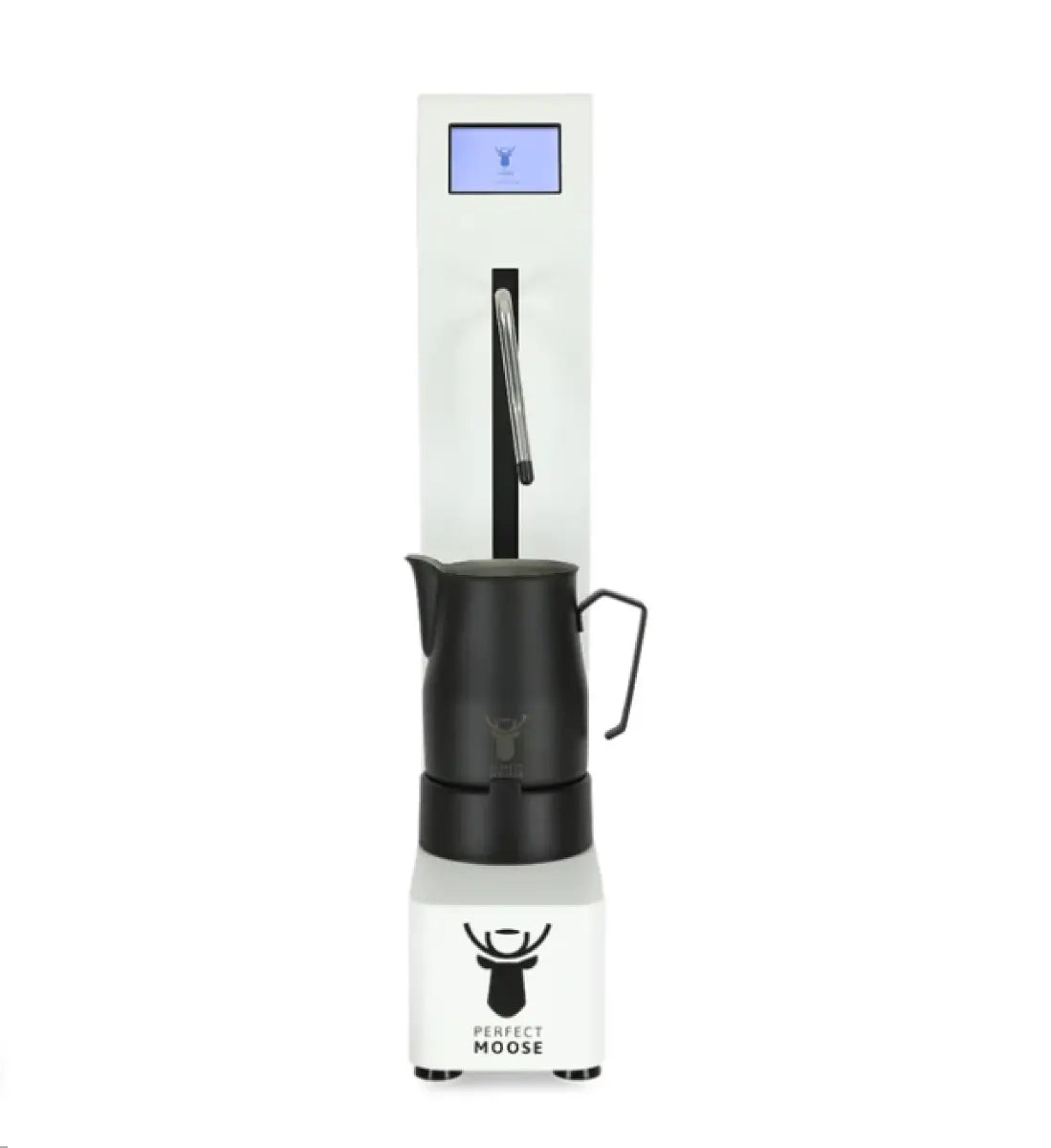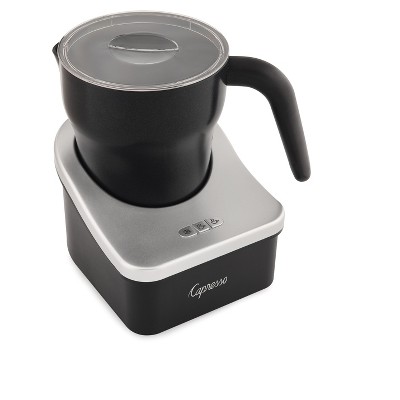We design tools like Milk Streamer that make real latte-art microfoam possible at home and at work. When you compare milk steamers and frothers, the details matter: microfoam fineness and stability, precise temperature control and safety, steam pressure versus induction frothing, RPM/torque for whisked models, materials, cleaning access, and the ability to maintain and repair with spares.
Create café-quality texture at home with NanoFoamer Pro.
What Makes a Great Milk Steamer
Milk streamer performance matters most for latte art, the goal is glossy, paint-like microfoam with tiny, even bubbles that hold a crisp pattern. Hitting and holding about 55-65°C / 130-149°F keeps sweetness and texture while avoiding scalding; you also want consistent steam or induction power so the milk spins into a stable vortex instead of splashing. A good pitcher helps that spin, while food-grade materials, auto-shutoff, and thermal cutoffs keep things safe. Quiet operation, a comfortable handle, and intuitive controls matter when you’re making back-to-back drinks. Finally, easy cleaning and descaling plus responsive support and spare parts extend product life. If you want hands-off microfoam with tight temperature windows and a true latte-art texture, our NanoFoamer Pro automatic microfoam maker is built for that result.
Key Features to Look for in 2025
Performance. Compare steam pressure or whisk/impeller power; look for PID or reliable presets, time to target temp, and consistency with dairy and alt-milks.
Build & Power. Stainless pitchers vs nonstick carafes, thick heat diffusers, sealed switches, induction bases, stable stands/carry options, and clean cord management.
Usability & Care. One-touch programs and manual modes, quick-rinse routines, removable whisk heads/impellers, descaling reminders, clear support docs, and a warranty with available parts. See our PRO spare parts and replacements and Quick Start Guides for what ongoing care should look like.
Top 16 Milk Steamers for 2025
1. Subminimal NanoFoamer Pro - Best Milk Steamer

We built NanoFoamer Pro to produce fine, glossy microfoam with precise temperature control and a stable vortex that supports latte art at home. Five program modes pair heating and aeration for different drink sizes and foam textures, while manual start/stop gives you creative control. The thick heat diffuser and magnetic NanoScreen help prevent hot spots and keep bubbles ultra-fine. The IPX-5 splash-resistant body, sealed connector, and included brush simplify cleaning. We support long-term ownership with spare parts, flow controllers for dairy and plant-based milks, and step-by-step Quick Start resources.
Key Highlights
-
Latte-art microfoam with uniform, tiny bubbles
-
Accurate temperature and repeatable programs
-
Robust materials and sealed electronics
-
Simple daily cleaning and rinse routine
-
Documentation, help articles, and spare parts
Standout Features
-
Programmed heating + aeration: Five profiles for cup size and texture.
-
Adjustable impeller height: Tuning for small drinks and alt-milks.
-
Magnetic NanoScreen: Consistent shear for superfine foam.
-
Heat diffuser: More even heating and fewer milk residues.
-
Support path: Quick Start, MasterClass access, and parts when you need them.
Ready for café-quality pours? Shop NanoFoamer Pro.
2. Flair Wizard Steamer (Flair Espresso Maker)

A dedicated steaming unit designed to pair with manual levers or compact setups, this model focuses on steady steam generation and usable pressure for true milk texturing. The wand allows you to roll milk and establish a vortex for controlled aeration, aiming for latte-art capable microfoam. A metal body and weighted base aid stability, while basic temperature feedback helps you stop before scalding. It’s best for home baristas who already have an espresso workflow but lack a wand. Cleaning involves purging the wand, wiping the tip, and descaling per schedule. Accessories may include different tips and a pitcher; portability is limited by the boiler mass but suitable for small counters and offices.
-
Key features: method (steam), materials (metal body), power (electric boiler), accessories (steam tips, pitcher)
-
Useful stats & info: temp cues, wand purge cleaning, compact footprint, limited warranty/brand support path
-
Pros: true steam for microfoam, controlled aeration, stable base, pairing with manual espresso
-
Cons: warm-up time, larger than whisk frothers, requires purge/descale routine
3. The MORNING Dream (Drink Morning)
.

Designed as a countertop frothing solution that complements capsule or compact espresso machines, this unit offers induction heating with preset programs for different foam densities. The carafe’s nonstick interior speeds up cleanup, and a shaped impeller/whisk targets small, even bubbles for latte-art attempts, though results depend on milk type and fill volume. Insulated walls help temperature stability, while a removable lid and pour spout aim for tidy transfers into your pitcher. It works for homes and offices wanting quick, hands-off foam without managing a steam wand. Travel is possible due to a small base, but the carafe still needs careful packing. Included accessories commonly cover a spare whisk and lid.
-
Key features: method (induction/whisk), materials (nonstick carafe), power (induction base), accessories (spare whisk/lid)
-
Useful stats & info: temp presets, dishwasher-safe parts noted by maker, compact size, limited warranty
-
Pros: quick presets, easy cleaning, quieter than wands, safe auto-shutoff
-
Cons: microfoam can skew dry if over-filled, less manual control than wands
4. De'Longhi Automatic Espresso Machines (De'Longhi)

Many De’Longhi super-automatics ship with integrated milk systems that heat and texture milk at the press of a button. They generally use steam or thermoblock-driven systems to create a fine foam suitable for cappuccinos, with adjustable froth levels. Carafes detach for storage and cleaning, while auto-rinses reduce buildup. These are ideal for offices or homes seeking one-touch drinks. For latte art, quality varies by model and milk freshness; a dedicated pitcher may help. Build quality tends toward plastic with metal accents, though higher tiers add stainless parts. Temperature is managed internally with profiles that aim for drinkable ranges without scalding; maintenance involves descaling cycles and cleaning the milk path regularly.
-
Key features: method (steam/auto milk), materials (plastic/metal mix), power (thermoblock/boiler), accessories (detachable carafes)
-
Useful stats & info: user-selectable froth levels, automatic rinses, guided descaling, standard warranty
-
Pros: true one-touch milk drinks, consistent temp control, detachable milk containers
-
Cons: latte-art microfoam varies, more parts to clean, larger footprint
5. Nespresso Aeroccino4 Milk Frother (Nespresso)

A compact induction frother with multiple foam programs, Aeroccino4 focuses on convenience: push a button to heat or foam milk to preset textures. The carafe’s nonstick surface and ergonomic handle speed up pouring and cleaning. It’s quiet and small enough for apartments, travel, or office desks with access to power. Temperature is preset around a drinkable range, and the whisk creates a fine foam suitable for cappuccino-style drinks; latte art is possible but often requires careful fill volumes and fresh milk. Included accessories typically cover the whisk and a lid, with dishwasher-safe parts specified by the maker. It’s best for users prioritizing speed and cleanup over manual steaming skills.
-
Key features: method (induction/whisk), materials (nonstick carafe), power (induction), accessories (whisk, lid)
-
Useful stats & info: multiple presets, dishwasher-safe components, compact storage, standard warranty
-
Pros: simple operation, quiet, quick cleanup, consistent heating
-
Cons: foam can run airy, limited manual control, small capacity for entertaining
6. Bellman Milk Steamers & Frothers (Bellman Espresso)

Bellman’s stovetop steamers create true steam using a compact pressure vessel, delivering wand-like control in small kitchens or on the go with a portable stove. The metal body and classic knob controls feel durable, and the wand can roll milk into a tight vortex for latte-art microfoam with practice. There’s no onboard temperature display; users rely on sound, touch, and a thermometer. Cleaning requires purging the wand and occasional descaling. It’s a favorite for campers or lever-machine owners who want real steam without an electric boiler. Accessories commonly include different tips and a safety valve. Heat-up time depends on stove power, and careful handling of hot surfaces is essential.
-
Key features: method (steam, stovetop), materials (stainless/metal), power (external heat), accessories (wand tips)
-
Useful stats & info: manual temp management, purge and descale, compact footprint, limited warranty
-
Pros: true steam microfoam, portable with stove, durable metal build
-
Cons: learning curve, slower heat-up, hot-surface handling required
7. Voltage Coffee Supply Milk Frothers and Steamers

Retailer assortment spanning induction frothers, standalone steamers, and replacement pitchers. Models typically feature presets for cappuccino/latte foam and nonstick or stainless interiors. Users can choose capacities and finishes to fit home or office counters, with bundles that add pitchers and spare whisks. Temperature targets are preset for drinkable ranges, while higher-spec steamers support manual texturing. Cleaning guidance varies by model; most include quick-rinse routines and descaling schedules. This option suits buyers comparing brands in one place, prioritizing delivery speed and availability. Support and warranty service route through the retailer and the original maker. Good for offices standardizing across several stations with similar controls and accessories.
-
Key features: method (varies), materials (stainless/nonstick), power (induction/steam), accessories (bundles/pitchers)
-
Useful stats & info: preset programs, cleaning specifics per model, size range, retailer and maker warranties
-
Pros: wide selection, bundle value, quick availability, finishes to match décor
-
Cons: feature sets vary widely, support path depends on brand, learning curve across models
8. Whole Latte Love , Capresso Froth Select (Whole Latte Love)

This retailer listing focuses on an induction frother known for simple presets and a lidded carafe. It heats and whisks milk for cappuccino, latte, or cold foam with push-button controls. The nonstick interior eases cleanup; some packages include extra whisks or pitchers. Temperature aims for a safe, drinkable window; for latte art, use fresh milk and avoid over-filling to limit airy foam. The compact base works for apartments or small offices. Warranty and support may route through both the retailer and the brand. It’s a practical pick for users wanting reliable foam with minimal attention, though results are less nuanced than a steam wand for classic rosettas and tulips.
-
Key features: method (induction/whisk), materials (nonstick carafe), power (induction), accessories (extra whisk/pitcher)
-
Useful stats & info: multiple foam modes, dishwasher-noted parts, small footprint, retailer warranty handling
-
Pros: straightforward presets, easy cleaning, quiet operation
-
Cons: microfoam can be airy, limited manual control, capacity constraints
9. Wally Milk , Automatic Milk Steamer (La Marzocco)

A counter-top automatic steamer intended for cafés and serious home bars, it uses controlled steam injection and temperature sensors to deliver repeatable milk texture. Profiles let you target latte-art microfoam or drier foam for cappuccinos. The stainless body, commercial wand, and drain tray suit frequent use; maintenance involves purging, wiping, and scheduled descaling. Temperature targets are set per recipe to keep milk in the sweet spot; alt-milk performance depends on settings and milk choice. It’s sized for service environments or home enthusiasts who want café equipment. Accessories include pitchers and tip options. The footprint and power draw exceed typical home frothers, but output and repeatability are strong.
-
Key features: method (steam), materials (stainless), power (commercial electric), accessories (pitchers, tips)
-
Useful stats & info: profile presets, purge/descale routines, larger footprint, manufacturer warranty
-
Pros: café-level steam, programmable texture, durable build
-
Cons: price class and size, requires drain/cleaning discipline, louder than induction
10. Miroco Electric Milk Frother (Walmart - Sunvalley Group)

A compact induction frother focused on push-button convenience, Miroco runs hot foam, warm foam, and cold foam programs. The nonstick interior and removable whisk streamline cleaning. Temperature presets produce drinkable milk; for latte art, careful volume control and fresh milk improve texture. Bundles can include extra whisks, lids, and carafes across retailer listings. It suits apartments, dorms, and small offices prioritizing speed and low noise over wand technique. The lightweight base and carafe store easily and travel in larger luggage. Warranty and support depend on retailer policies and brand coverage, typically straightforward within return windows.
-
Key features: method (induction/whisk), materials (nonstick carafe), power (induction), accessories (spare whisk/lid)
-
Useful stats & info: multiple presets, rinse/quick clean, small footprint, basic warranty
-
Pros: quiet, easy to use, affordable bundles
-
Cons: airy foam risk at high fill, less control than a wand, finish can scuff over time
11. Ovente Electric Milk Frother (Walmart)

An induction/whisk frother offering hot and cold programs, Ovente emphasizes simple controls and a compact footprint. The carafe typically features a nonstick lining for quick rinses; the whisk removes for cleaning. Preset heat targets aim for drinkable temperatures and repeatable foam density, though latte-art microfoam depends on milk freshness and volume. Bundled accessories vary by listing, occasionally adding extra whisks or pitchers. Suited to home users who want reliable foam fast, it’s quiet and space-efficient. Materials are a plastic/metal blend. Support and warranty route via retailer and brand programs, with returns handled through store policies.
-
Key features: method (induction/whisk), materials (nonstick carafe), power (induction), accessories (spare whisk/pitcher)
-
Useful stats & info: preset modes, quick-rinse cleaning, compact size, basic warranty
-
Pros: easy presets, quiet operation, small footprint
-
Cons: microfoam may be loose, limited capacity, nonstick requires gentle care
12. Instant Pot MagicFroth Milk Frother (Best Buy)

This appliance leverages a familiar brand ecosystem and provides preset programs for hot foam, warm foam, and cold foam. Induction heating produces even warmth while a removable whisk creates texture. The nonstick carafe streamlines cleanup; many parts are labeled dishwasher-safe by the maker. The unit fits small counters and offices, and it’s quiet compared to steam wands. For latte art, use whole milk, keep volumes conservative, and pour immediately. Bundles may add whisks or pitchers at retail. Warranty and support run through Best Buy and the brand. It’s a straightforward, low-effort choice for households that want consistent foam without managing a steam wand.
-
Key features: method (induction/whisk), materials (nonstick carafe), power (induction), accessories (extra whisk/pitcher options)
-
Useful stats & info: multiple presets, dishwasher-noted parts, compact base, standard warranty
-
Pros: easy, quiet, consistent heating
-
Cons: less control over microfoam, carafe capacity limits, nonstick wear over time
13. Bodum Barista Electric Milk Frother (Bodum US)

Bodum’s countertop frother uses induction heating with a removable whisk to produce hot or cold foam. The minimalist design pairs a handled carafe with a simple base. Programs aim for cappuccino or latte textures; temperature is preset to a comfortable range. Cleaning involves removing the whisk and rinsing the carafe; some versions specify dishwasher-safe components. It’s best for home users and small offices that value quiet operation and simple controls. Materials include plastic and metal, with a nonstick interior in many listings. Accessories often cover spare whisks and lids. Latte-art pours are possible with fresh milk and attention to fill lines to avoid excess aeration.
-
Key features: method (induction/whisk), materials (nonstick carafe), power (induction), accessories (whisk/lid)
-
Useful stats & info: preset programs, rinse cleaning, small footprint, brand warranty
-
Pros: quiet, easy controls, tidy pouring
-
Cons: foam can be airy, limited manual control, smaller jug volume
14. Philips Baristina Milk Frother (Williams-Sonoma)

This induction frother is positioned for premium homes seeking neat, repeatable foam with a smart-looking carafe. Presets cover hot foam, warm foam, and cold foam, while a removable whisk builds texture. Temperature is tuned for drinkable milk; the spout supports cleaner pours. The nonstick interior quickens cleaning; some parts may be dishwasher-safe per retail notes. It suits design-conscious kitchens and offices needing quick milk drinks. Bundles vary by retailer, sometimes including spare whisks. Latte-art capability is serviceable with fresh milk and proper volumes, but it won’t match a skilled steam wand in nuance.
-
Key features: method (induction/whisk), materials (nonstick/stainless accents), power (induction), accessories (spare whisk)
-
Useful stats & info: preset temps, quick-rinse clean, medium size, retailer/manufacturer warranty
-
Pros: attractive design, quiet presets, easy cleanup
-
Cons: less granular control, nonstick care required, capacity not ideal for entertaining
15. Capresso Froth Pro Automatic Milk Frother (Target)
A longstanding induction frother with clear, push-button modes for hot and cold foam. The carafe’s nonstick lining and removable whisk keep cleanup quick. Temperature presets aim for a comfortable serving window; foam density options cover cappuccino to latte-style textures. It’s compact and quiet, fitting small kitchens and office nooks. Accessories often include extra whisks and a lid; retailers vary in bundles. For latte art, keep milk fresh and fill lines modest to avoid dry foam. Warranty and support go through the retailer and brand. It’s a reliable pick for everyday convenience without learning wand technique.
-
Key features: method (induction/whisk), materials (nonstick carafe), power (induction), accessories (whisks/lid)
-
Useful stats & info: multiple presets, dishwasher-labeled parts, compact base, standard warranty
-
Pros: simple, quiet, easy to clean
-
Cons: microfoam can be loose, limited capacity, finish requires gentle care
16. Perfect Moose Epic Greg Milk Steamer (Coffee Machine Depot)

A semi-automatic commercial steamer designed for consistent milk texture in busy settings. It uses steam injection with sensors to hit set temperatures and repeat foam quality across shifts. Stainless construction and a pro wand support latte-art microfoam with proper pitchers. It’s ideal for cafés, coffee carts, or high-volume offices that want barista-level results without constant attention. Cleaning involves wand purge/wipe and regular descaling. Accessories include pitchers and different tips in many packages. The footprint and noise exceed home frothers, and power requirements are commercial-leaning. A strong choice when throughput and repeatability matter more than compactness.
-
Key features: method (steam), materials (stainless), power (commercial boiler), accessories (pitchers, tips)
-
Useful stats & info: temp profiles, purge/descale, large size/weight, commercial warranty
-
Pros: repeatable microfoam, robust build, serviceable for volume
-
Cons: bulky, louder, beyond typical home needs
Coffee-at-Home Trends & Foam Science
Most barista training and educational outlets align on 55-65°C (131-149°F) for steaming dairy milk, with ~70°C (158°F) as an upper limit before flavor and texture degrade; buyers should favor machines or programs that consistently hit that window.
Foam quality hinges on milk proteins (caseins and whey) and how you aerate and shear the milk; processing, protein ratio, pH, and lipids all affect foam stability. This is why technique, pitcher size, and controlled power matter, and why plant-based “barista” formulations can perform differently.
Finally, keep milk handling safe: use pasteurized milk, keep it cold before steaming, and avoid leaving it in the temperature “danger zone” (40-140°F). Build a rinse-and-wipe routine and descale on schedule to maintain taste and hygiene.
FAQ
What temperature should I steam milk for latte art?
Aim for 55-65°C (130-149°F) for dairy milk. This range balances sweetness and stability while avoiding scalding. Start the pour immediately after texturing to preserve the glossy surface and tight bubbles. For hotter drinks, stay under 70°C (158°F) to keep proteins from breaking down and flavors from flattening. Use a thermometer while you learn, then rely on pitcher feel and sound cues for consistency.
Steam vs induction vs whisk, what’s the difference?
Steam wands inject steam for classic café microfoam and the most manual control. Induction frothers heat the carafe and spin a whisk or impeller for hands-off, repeatable foams. Handheld whisks aerate quickly but require separate heating. Choose steam for maximum nuance, induction for speed and cleanliness, and whisks for travel or ultra-small spaces.
How do I get glossy microfoam?
Use fresh, cold milk; fill below the max line; start with controlled aeration, then focus on a strong vortex to homogenize bubbles. Target 55-65°C and pour immediately. Keep pitchers clean and sized to your drink (often 12-15 oz for home). A well-tuned device with stable power makes consistency easier.
Will it work with oat or almond milk?
Yes, choose barista formulations designed for steam/froth. Many perform better slightly cooler than dairy and with gentler aeration. Use smaller volumes and pour right away to keep definition for art. Device presets for alt-milk help, but technique and brand recipes still matter.
How do I clean and descale safely?
Purge and wipe steam wands after every use; for induction carafes, rinse warm, wipe the whisk/impeller, and avoid abrasive tools on nonstick. Run periodic descaling per the manual, and store the device dry. Good hygiene protects flavor and extends product life
Make latte-art microfoam the easy way with NanoFoamer Pro.


